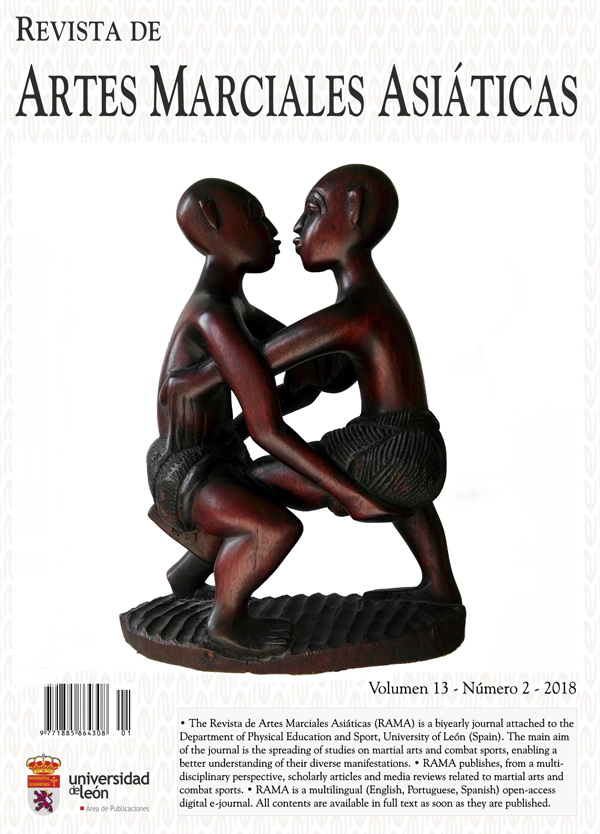Relatório sobre a Conference for the 100th Anniversary of Choi Hong Hi: Taekwon-Do and Life; How to View Choi Hong Hi
DOI:
https://doi.org/10.18002/rama.v13i2.5628Palavras-chave:
Taekwondo, Federação Internacional de Taekwondo, ITF, Complexo vermelho, Fundação para a Promoção do Taekwondo, artes marciais, desportos de combateEntidades:
Keimyung University (grant #20180269)Resumo
Apesar da sua enorme influência no taekwondo, o General Choi Hong Hi foi durante muito tempo uma figura controversa na República da Coreia (ROK; Coreia do Sul). A “Conference for the 100th Anniversary of Choi Hong Hi: Taekwon-Do and Life; How to View Choi Hong Hi” celebrou-se no passado dia 28 de novembro de 2018, na Korea National Sport University. O presente relatório analisa esta conferência, que teve como objetivo difundir os trabalhos dos palestrantes a uma audiência mais ampla e estabelecer novas linhas de debate académico sobre o taekwondo da Federação Internacional de Taekwondo (ITF). Esta conferência permitiu também apresentar alguns problemas existentes na literatura sobre o taekwondo;, ou seja, que a literatura da ITF é bastante ofuscada pela pesquisa sobre sua contraparte olímpica. Por outro lado, parece que o único órgão de governo do taekwondo da ROK que está interessado em restabelecer o legado do General Choi Hong Hi é a Fundação para a Promoção do Taekwondo. Este tema era tabu há algumas décadas, mas o “clima” político existente no país tem vindo a mudar e o legado do General está ressurgindo lentamente.
Downloads
Métricas alternativas
Referências
Adrogué, M. E. (2010). ITF Taekwon-Do & sine wave as “sequential motion”. Totally Tae Kwon Do, (15), 19-25.
Cho, M. (2007). From street corners to plaza: The production of festive civic space in Seoul. In M. Douglass, K. C. Ho & G. K. Ooi (eds.), Globalization, the City and Civil Society in Pacific Asia: The Social Production of Civic Spaces (Rethinking Globalizations) (pp. 194-210). London & New York: Routledge.
Choi, H. H. (1987). Encyclopedia of Taekwon-Do, volume 1 (3rd ed.). Mississauga, Canada: International Taekwon-Do Federation.
Choi, H. H. (c2000). Taekwon-Do and I, volume 2: the vision of exile: Any place under heaven is do-jang. N.p.: International Taekwon-Do Federation.
Gillis A. (2016). A killing art: The untold history of Tae Kwon Do – updated and revised edition (1st ed.). Toronto, Canada: ECW Press, Inc.
Heller J., Peric T., Dlouha R., Kohlikova E., Melichna J., & Novakova H. (1998). Physiological profiles of male and female Taekwondo (ITF) black belts. Journal of Sports Sciences, 16(3), 243-249. doi: http://doi.org/10.1080/026404198366768
Heo, I. U. (2015). The study of Taekwondo spirit before the 1960s. Taekwondo Journal of Kukkiwon, 6(1), 1-20.
Johnson, J. A., & Vitale, G. (2018). Taekwondo diplomacy: New possibilities for peace on the Korean Peninsula. Physical Activity Review, 6, 237-250. doi: http://doi.org/10.16926/par.2018.06.28
Kim D. H. (2018, Nov. 3). South and North Korea to integrate respective branches of Taekwondo. Hankyoreh. Retrieved from http://english.hani.co.kr/arti/english_edition/e_northkorea/868668.html?fbclid=IwAR1OOkM3tor9_MVLZMb0ms4gExcdT9Ro1FEjcy96KitKtY5ZWD85a3eHqEI
Kim, D. K., Kim, G. H., & Kim, Y. K. (2004). Choi, Hong Hi and Kim, Un Young’s Taekwondo philosophy and globalization strategy. Philosophy of Movement: The Journal of Korean Philosophic Society for Sport and Dance, 12(2), 363-383. [in Korean].
Korea Foundation. 2013. Taekwondo: The unity of body, mind and spirit. Seoul: Seoul Selection.
Moenig U. (2015). Taekwondo” from a martial art to a combat sport. New York, NY: Routledge.
Moenig U., Cho S., & Kwak T. Y. (2014). Evidence of Taekwondo’s roots in Karate: An analysis of the technical content of early Taekwondo literature. Korea Journal, 54(2), 150-178.
Nishiyama H., & Brown R. C. (1960). Karate: the art of “empty hand” fighting. North Clarendon, VT: Tuttle.
Wąsik J. (2007). The physical basis of the twimyo nomo yop chagi test in Taekwon-Do ITF. Archives of Budo, 3, 82-85.
Wąsik J. (2009). Structure of movement of a turning technique used in the event of special techniques in Taekwon-do ITF. Archives of Budo, 5, 111-115.
Wąsik J. (2011). Kinematics and kinetics of Taekwon-do side kick. Journal of Human Kinetics, 30, 13-20. doi: https://doi.org/10.2478/v10078-011-0068-z
Downloads
Publicado
Como Citar
Edição
Secção
Licença
Direitos de Autor (c) 2018 John A. Johnson, Sanko Lewis

Este trabalho encontra-se publicado com a Licença Internacional Creative Commons Atribuição-NãoComercial-CompartilhaIgual 4.0.
Os autores que publicam nesta Revista estão de acordo com os seguintes termos:
- Os autores cedem, de forma exclusiva, os direitos de exploração (reprodução, distribuição, comunicação pública, transformação) à Universidade de Léon, podendo estabelecer, em separado, acordos adicionais para a distribuição não exclusiva da versão do artigo publicado na Revista (por exemplo: alojar no repertório institucional ou publicá-lo num livro), com o reconhecimento da publicação inicial nesta Revista.
- O trabalho encontra-se na Creative Commons Attribution-Non Commercial-Share Alike 4.0 International License. Pode-se consultar aqui o resumo e o texto legal da licença.
- Permite-se, e sugere-se, que os autores difundam electronicamente as versões pré-impressão (versão antes de ser avaliada) e pós-impressão (versão avaliada e aceite para publicação das suas obras antes da sua publicação), favorecendo a sua circulação e difusão, e com ela o possível aumento da sua citação e alcance pela comunidade académica.











